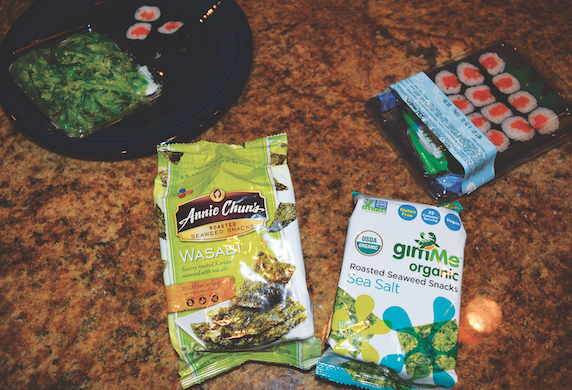A new superfood in town
November 17, 2015
Seaweed may not be the most appetizing snack at first glance, but taking a deeper look may convince some to give it a try. Not only is seaweed, also called kelp, a plentiful vegetable, but its health benefits are through the roof. For example, it has more Vitamin C than oranges, and is one of the richest plant sources of calcium existing today. Seaweed has recently surged in popularity in the US and it is becoming a trend to include it in your daily diet.
One popular way to eat seaweed is the roasted seaweed snack, consisting of little roasted seaweed squares that are prepared with sea salt and olive oil. Other varieties include seaweed chips, using it in a wrap, kelp noodles, salad, preparing it in a soup, and of course, sushi. Another form is dulse, a red seaweed that grows off the coast of Ireland and Maine, which has a reputation of looking and tasting like bacon.
“The seaweed dulse is a fat free food that is rich in vitamin B6, dietary and soluble fiber, protein, iodine and potassium. It has one of the highest iron content of any sea vegetable,” said Bob Nesbitt, Health Coach Certified Transformational Nutrition Coach (CTNC).
On a medical level, it contains natural iodine which helps manage thyroid function. Seaweed also has anti-viral, anti-bacterial, and anti-inflammatory properties, and is used in many home remedy medicines. It can prevent allergies and infections, type two diabetes, lowers blood pressure and normalizes cholesterol levels. Eating seaweed increases the amount of endorphin chemicals in your brain, improves liver function, stabilizes blood sugar, and gives a soft glow to your skin.
“Iodine deficiency has on-going research connected to many diseases,” said Health Coach CTNC Rene Deal.
Seaweed requires no fresh water or fertilizer, making it one of the most sustainable and nutritious crops in the world. It grows in salt water absorbing dissolved nitrogen, phosphorous, and carbon dioxide directly from the sea. Seaweed has a high mineral content, especially: iodine, calcium, iron, and magnesium, and it contains up to 70 percent protein content. Seaweed has many noticeable heath benefits, including: soft healthy hair, improvement in memory, clear skin, good eyesight, good oral hygiene and it improves the immune system.
Seaweed is really high in omega-3 fatty acids, which are important in brain development and can help prevent heart disease,” junior Emera Balok said.
— Emera Balok
Seaweed does wonders environmentally. Kelp can grow as much as three-quarters of an inch a day bringing in approximately 30-60 tons a year, about the same per-acre yield as a potato farmer. As we run out of room destroying forests for land-based agriculture, delving into our extensive sea space for food seems like a fantastic plan. At this rate oceans could be fish-less by 2025, but seaweed farming can rehabilitate the ocean’s threatened ecosystems and help to revive coastal economies. Seaweed is a potential source of human food, biofuel and animal feed. Some hope to one day see this growing crop take the place of corn and soy as a healthier alternative to a filler food.
“Seaweed is a very sustainable resource. It requires no effort, no farmer or factory to grow and it regenerates on it’s own. In a time of global warming and dwindling natural resources, it kind of becomes a SUPER-superfood!” said Heath Coach CTNC Christina Harder Neuner.
Seaweed is climbing the ranks in nutrients, benefits as well as popularity. All of the seaweed varieties mentioned above can be purchased at local stores such as Kowalski’s and the CoOp. Do not be fooled by this appearance, as more people like seaweed than one would think. No matter what the official title is, seaweed obviously has many nutritional benefits, medical purposes and environmental advancements. This ever growing green really is one for the books.














Megan Karnuth • Nov 29, 2015 at 10:52 pm
On my quest to start eating healthier in preparation for the soccer season I found this very helpful! This article was very informative and I knew little about seaweed before but now I feel like an expert.
Sam Begin • Nov 29, 2015 at 6:20 pm
This article served as a great way to get informed on a subject few know about and I definitely know a lot more about seaweed than I did before. I maybe would have added more information about seaweed as a food and not as a plant. Overall, great job!
Grace Donner • Nov 25, 2015 at 7:34 am
The amount of facts you added were amazing, I had no clue that seaweed had any of these effects. The quotes were also in depth which means good interviews took place. This article definitely persuades readers into thinking about trying this food.
Alex Schwarz • Nov 24, 2015 at 8:09 pm
This article was very well written in the fact quote organization, and because of that it made it very easy to read and absorb all of the very fascinating info.
Sam Gater • Nov 24, 2015 at 5:27 pm
The fact quote form was put together seamlessly. It contained a lot of information and had helpful tips, such as the different ways to prepare seaweed. I also appreciated the facts about the economic benefits.
Kaitlyn Wylie • Nov 23, 2015 at 9:08 am
This article has a lot of information about the benefits of eating seaweed, it was very formative. I personally did not know that much could be beneficial from using it. This was a great article with many examples for good use.
Joe Rice • Nov 23, 2015 at 8:18 am
This article has great visuals and quotes! I never could have imagined all of the benefits of seaweed. Very well written overall.
Shenyn Gale • Nov 22, 2015 at 1:08 pm
Its really Important to eat healthy that’s why I chose to read this article. I never knew seaweed was so good for you! This article was full of content which was both informative and beneficial for the reader. I thought this article was very well written and definitely worth the read.
Lauren Feldkamp • Nov 19, 2015 at 5:50 pm
My mom is definitely a healthy food freak so that first drew me to read this article when I saw the title, also who doesn’t love hearing about new and weird healthy foods to try! I thought this article was really informative to someone like myself who doesn’t know anything at all about seaweed and it’s benefits. The amount of information this article held was just enough for the reader to be astounded by and maybe even enough for them to hop on the seaweed bandwagon.